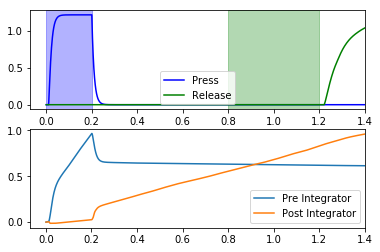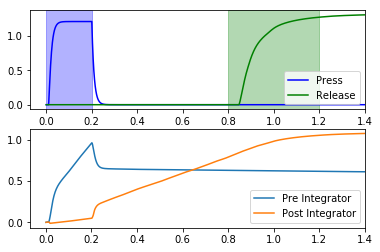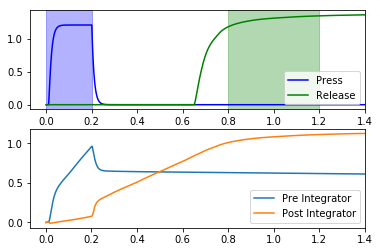Additional tips and tricks for designing networks¶
This tutorial assumes that you have read the network_design
tutorial, and have designed a network or two. Here, we will give a few
advanced tips and tricks for designing networks that can be reused
flexibly. In particular, these tips will use the config system, so
we will also assume that you have gone over the config tutorial.
Briefly, the general principles covered in this tutorial are
- Accept a network argument
- Accept a config argument for groups of parameters
We will demonstrate these principles using the two examples from the
network_design tutorial.
In [1]:
import numpy as np
import matplotlib.pyplot as plt
%matplotlib inline
import nengo
from nengo.dists import Choice
from nengo.processes import Piecewise
from nengo.utils.ipython import hide_input
def test_integrators(net):
with net:
piecewise = Piecewise({
0: 0,
0.2: 0.5,
1: 0,
2: -1,
3: 0,
4: 1,
5: 0
})
piecewise_inp = nengo.Node(piecewise)
nengo.Connection(piecewise_inp, net.pre_integrator.input)
input_probe = nengo.Probe(piecewise_inp)
pre_probe = nengo.Probe(net.pre_integrator.ensemble, synapse=0.01)
post_probe = nengo.Probe(net.post_integrator.ensemble, synapse=0.01)
with nengo.Simulator(net) as sim:
sim.run(6)
plt.figure()
plt.plot(sim.trange(), sim.data[input_probe], color='k')
plt.plot(sim.trange(), sim.data[pre_probe], color='b')
plt.plot(sim.trange(), sim.data[post_probe], color='g')
hide_input()
Out[1]:
1. Accept a network argument¶
Typically, a network-creation function will take a set of arguments,
which affect some important parts of the network. When testing the
network, it’s common to change several parameters to see how they affect
the network. One way to do this is to add more and more arguments to
your function; this quickly gets out of hand. Instead, use the
config system, which enables us to set network-level defaults for
all Nengo objects.
You can either do this by creating your network in the context of some other network, or you can modify your function to optionally take in a network instance, which you will build your objects into.
In the example below, we change both integrators to use LIFRate
neurons by changing the config object in the network both
integrators are build within. We also change the post_integrator to
use a very small radius by passing in a network which has its default
radius modified.
In [2]:
def Integrator(n_neurons, dimensions, tau=0.1, net=None):
if net is None:
net = nengo.Network()
with net:
net.input = nengo.Node(size_in=dimensions)
net.ensemble = nengo.Ensemble(n_neurons, dimensions=dimensions)
nengo.Connection(net.ensemble, net.ensemble, synapse=tau)
nengo.Connection(net.input, net.ensemble, synapse=None, transform=tau)
return net
net = nengo.Network(label="Two integrators")
with net:
# Make both integrators use LIFRate neurons
net.config[nengo.Ensemble].neuron_type = nengo.LIFRate()
net.pre_integrator = Integrator(50, 1)
# Lower the radius of the post_integrator
net.post_integrator = nengo.Network()
net.post_integrator.config[nengo.Ensemble].radius = 0.2
Integrator(50, 1, net=net.post_integrator)
nengo.Connection(net.pre_integrator.ensemble, net.post_integrator.input)
test_integrators(net)
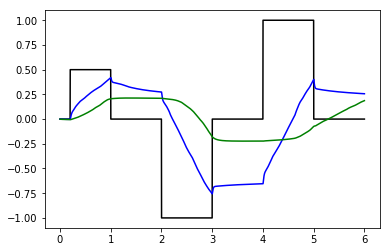
2. Accept a config argument for groups of parameters¶
Often, you will not want to use the network-level defaults for all of
your objects. Some objects need certain things overwritten, while others
need other values overwritten. Again, it is possible to deal with this
issue by adding more and more parameters, but this quickly gets out of
hand. Instead, add a small number of arguments that optionally accept a
config object, which allows for setting multiple parameters at once.
In the coupled integrator network example, we make two connections. We
have to be careful changing the defaults for those connections, as they
are wildly different; one is a recurrent connection from an ensemble to
itself, while the other is a connection from a node to an ensemble. We
will accept a config object for the recurrent connection to make
this easier.
In [3]:
def Integrator(n_neurons, dimensions, recurrent_config=None, net=None):
if net is None:
net = nengo.Network()
if recurrent_config is None:
recurrent_config = nengo.Config(nengo.Connection)
recurrent_config[nengo.Connection].synapse = nengo.Lowpass(0.1)
with net:
net.input = nengo.Node(size_in=dimensions)
net.ensemble = nengo.Ensemble(n_neurons, dimensions=dimensions)
with recurrent_config:
nengo.Connection(net.ensemble, net.ensemble)
tau = nengo.Config.default(nengo.Connection, 'synapse').tau
nengo.Connection(net.input, net.ensemble, synapse=None, transform=tau)
return net
net = nengo.Network(label="Two integrators")
with net:
# Make both integrators use LIFRate neurons
net.config[nengo.Ensemble].neuron_type = nengo.LIFRate()
net.pre_integrator = Integrator(50, 1)
# Give the post_integrator a shorter tau (should make integration fail)
recurrent_config = nengo.Config(nengo.Connection)
recurrent_config[nengo.Connection].synapse = nengo.Lowpass(0.01)
net.post_integrator = Integrator(50, 1, recurrent_config=recurrent_config)
nengo.Connection(net.pre_integrator.ensemble, net.post_integrator.input)
test_integrators(net)
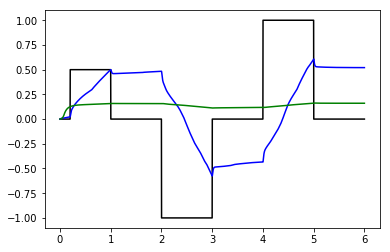
Longer example: double integrator network¶
Recall in the previous tutorial that we created a model that released a
lever 0.6 to 1.0 seconds after pressing a lever. Let’s use the above
principles, and the config system in general, to improve the code
constructing this model.
In [4]:
def controlled_integrator(n_neurons,
dimensions,
recurrent_config=None,
net=None):
if net is None:
net = nengo.Network()
if recurrent_config is None:
recurrent_config = nengo.Config(nengo.Connection)
recurrent_config[nengo.Connection].synapse = nengo.Lowpass(0.1)
with net:
net.ensemble = nengo.Ensemble(n_neurons, dimensions=dimensions + 1)
with recurrent_config:
nengo.Connection(
net.ensemble,
net.ensemble[:dimensions],
function=lambda x: x[:-1] * (1.0 - x[-1]))
return net
def medial_pfc(coupling_strength,
n_neurons_per_integrator=200,
recurrent_config=None,
tau=0.1,
net=None):
if net is None:
net = nengo.Network()
with net:
recurrent_config = nengo.Config(nengo.Connection)
recurrent_config[nengo.Connection].synapse = nengo.Lowpass(tau)
net.pre = controlled_integrator(n_neurons_per_integrator, 1,
recurrent_config)
net.post = controlled_integrator(n_neurons_per_integrator, 1,
recurrent_config)
nengo.Connection(
net.pre.ensemble[0],
net.post.ensemble[0],
transform=coupling_strength)
return net
def motor_cortex(command_threshold,
n_neurons_per_command=30,
ens_config=None,
net=None):
if net is None:
net = nengo.Network()
if ens_config is None:
ens_config = nengo.Config(nengo.Ensemble)
ens_config[nengo.Ensemble].encoders = Choice([[1]])
ens_config[nengo.Ensemble].intercepts = Choice([command_threshold])
with net:
with ens_config:
net.press = nengo.Ensemble(n_neurons_per_command, dimensions=1)
net.release = nengo.Ensemble(n_neurons_per_command, dimensions=1)
return net
def double_integrator(mpfc_coupling_strength,
command_threshold,
press_to_pre_gain=3,
press_to_post_control=-6,
recurrent_tau=0.1,
net=None):
if net is None:
net = nengo.Network()
with net:
net.mpfc = medial_pfc(mpfc_coupling_strength)
net.motor = motor_cortex(command_threshold)
nengo.Connection(
net.motor.press,
net.mpfc.pre.ensemble[0],
transform=recurrent_tau * press_to_pre_gain)
nengo.Connection(
net.motor.press,
net.mpfc.post.ensemble[1],
transform=press_to_post_control)
nengo.Connection(net.mpfc.post.ensemble[0], net.motor.release)
return net
def test_doubleintegrator(net):
# Provide input and probe outside of network construction,
# for more flexibility
with net:
nengo.Connection(
nengo.Node(lambda t: 1 if t < 0.2 else 0), net.motor.press)
pr_press = nengo.Probe(net.motor.press, synapse=0.01)
pr_release = nengo.Probe(net.motor.release, synapse=0.01)
pr_pre_int = nengo.Probe(net.mpfc.pre.ensemble[0], synapse=0.01)
pr_post_int = nengo.Probe(net.mpfc.post.ensemble[0], synapse=0.01)
with nengo.Simulator(net) as sim:
sim.run(1.4)
t = sim.trange()
plt.figure()
plt.subplot(2, 1, 1)
plt.plot(t, sim.data[pr_press], c='b', label="Press")
plt.plot(t, sim.data[pr_release], c='g', label="Release")
plt.axvspan(0, 0.2, color='b', alpha=0.3)
plt.axvspan(0.8, 1.2, color='g', alpha=0.3)
plt.xlim(right=1.4)
plt.legend(loc="best")
plt.subplot(2, 1, 2)
plt.plot(t, sim.data[pr_pre_int], label="Pre Integrator")
plt.plot(t, sim.data[pr_post_int], label="Post Integrator")
plt.xlim(right=1.4)
plt.legend(loc="best")
for coupling_strength in (0.11, 0.16, 0.21):
net = nengo.Network(seed=0) # Set seed here instead
# Try the same network with LIFRate neurons
net.config[nengo.Ensemble].neuron_type = nengo.LIFRate()
net = double_integrator(
mpfc_coupling_strength=coupling_strength,
command_threshold=0.85,
net=net)
test_doubleintegrator(net)
